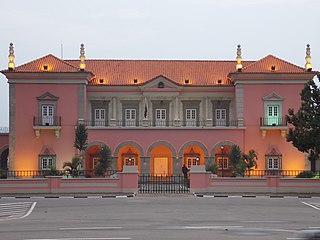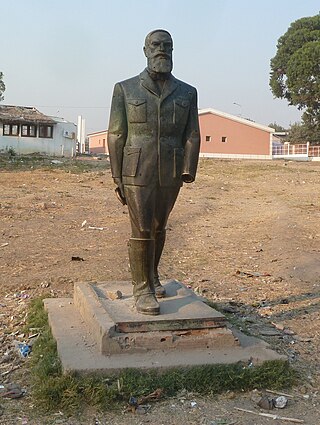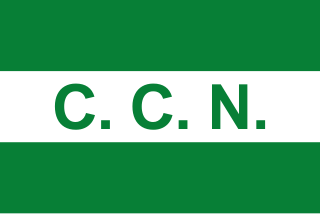Related Research Articles

Huambo, formerly Nova Lisboa, is the third-most populous city in Angola, after the capital city Luanda and Lubango, with a population of 595,304 in the city and a population of 713,134 in the municipality of Huambo. The city is the capital of the province of Huambo and is located about 220 km E from Benguela and 600 km SE from Luanda. Huambo is a main hub on the Caminho de Ferro de Benguela (CFB), which runs from the port of Lobito to the Democratic Republic of the Congo's southernmost province, Katanga. Huambo is served by the Albano Machado Airport.

Namibe Province is a province of Angola. Under Portuguese rule it was the Moçâmedes District. It has an area of 57,091 km2 and had a 2014 census population of 495,326. The port and city of Moçâmedes is the capital of the province with a population of 250,000 in 2014. Iona National Park lies within the province.
Alda Ferreira Pires Barreto de Lara Albuquerque, known as Alda Lara was a Portuguese-language Angolan poet.

The Ovimbundu, also known as the Southern Mbundu, are a Bantu ethnic group who live on the Bié Plateau of central Angola and in the coastal strip west of these highlands. As the largest ethnic group in Angola, they make up 38 percent of the country's population. Overwhelmingly the Ovimbundu follow Christianity, mainly the Igreja Evangélica Congregacional de Angola (IECA), founded by American missionaries, and the Catholic Church. However, some still retain beliefs and practices from African traditional religions.

Cuíto, formerly known as Silva Porto, is a city and municipality in central Angola, capital of Bié Province. The municipality had a population of 450,881 in 2014. Projected to be the tenth fastest growing city on the African continent between 2020 and 2025, with a 5.56% growth.

Henrique Mitchell de Paiva Cabral Couceiro was a Portuguese soldier, colonial governor, monarchist politician and counter-revolutionary; he was notable for his role during the colonial occupation of Angola and Mozambique and for his dedication to the Monarchist Cause during the period of the First Portuguese Republic through the founding of the Monarchy of the North.

António Francisco Ferreira da Silva Porto was a Portuguese trader and explorer in Angola, in the Portuguese West Africa.

The Archdiocese of Huambo is a Latin Metropolitan archdiocese of the Roman Catholic Church in western Angola.

The Bailundo revolt was an insurrection launched by the Ovimbundu kingdom of Bailundo and its allies against the Portuguese Empire. The revolt was prompted by the sudden decline of the price of root rubber, pitting the indigenous population against European immigrants and aboriginal loyalists. The revolt lasted between 1902 and 1904, ending in a Portuguese victory.
In the 1930s in Angola the Portuguese colonial government of António de Oliveira Salazar cut spending on colonization, leading to less emigration to Angola and a decline in the population of Portuguese Angolans.
In the 1920s in Angola mining became the primary source of revenue for the colonial government.

The Kingdom of Bailundo, also known as Bailundu, Mbailundu or Mbalundu, is an Angolan Ovimbundu kingdom based in the modern-day province of Huambo, in the central highlands of Angola. It was one of the largest and most powerful Ovimbundu kingdoms. Some news reports state the kingdom was founded in the 15th century, however oral histories and archival evidence suggest it emerged as a political entity around 1700. The kingdom was initially called Halavala.
Viye was one of the traditional Ovimbundu kingdoms, located in the central plateau of Angola. Its capital city was Ecovongo.

Ganguela or Nganguela is the name of a small ethnic group living in Angola, but since colonial times the term has been applied to a number of peoples East of the Bié Plateau. In addition to the Nganguela proper, this ethnographic category includes the Lwena (Luena), the Luvale, the Mbunda, the Lwimbi, the Camachi and others. They speak the languages of the Ngangela-Nyemba subfamily, which include Luchazi, Nkangala and Nyemba.
Ferreira is a Portuguese and Galician toponymic and occupational surname, meaning "iron mine" and also the feminine variant of "blacksmith" ("ferreiro"), related to ironworks.

The Companhia Colonial de Navegação (CCN) was a Portuguese shipping company that was founded in 1922 and merged into another company in 1974. Its ships carried freight as well as passengers. It was perhaps best known during the Second World War, when its ships, flying the neutral Portuguese flag, were some of the few to provide transatlantic service.
The Portuguese–Ovimbundu War, also known as the War of 1774–1778, was an armed conflict between the kingdoms of the Ovimbundu people, mainly in the figure of the Bailundo and Viye kingdoms, against the Kingdom of Portugal.
References
- ↑ Clarence-Smith, W. G. (1985). The Third Portuguese Empire. p. 105.
- ↑ Clarence-Smith, W. G. (1985). The Third Portuguese Empire. p. 88.
- ↑ Stearns, Peter N.; William Leonard Langer (2001). The Encyclopedia of World History: Ancient, Medieval, and Modern. p. 595.
- ↑ Walker, John Frederick (2004). A Certain Curve of Horn: The Hundred-Year Quest for the Giant Sable Antelope of Angola . pp. 40–41.
- ↑ Rotberg, Robert I. (1965). A Political History of Tropical Africa . pp. 302.
- ↑ Satre, Lowell Joseph (1913). Chocolate on Trial. pp. 1911–1913.
- ↑ Fage, John Donnelly; Desmond J. Clark; A. D. Roberts; Roland Oliver (1986). The Cambridge History of Africa: 1905 to 1940. p. 521.